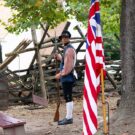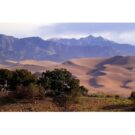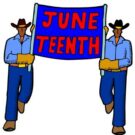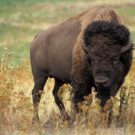Pioneer Militia in the Early 1800s
Did you know… by Sandra Merville Hart The law made every male between 18 and 45 part of the Militia of the day. This was usually one regiment plus officers for each county. Met yearly for drills Our law required every company meet once a year for drills. After this, the entire regiment met for a one day drill at the county seat or some other designated location. Special rifle regiments In addition, one or more rifle regiments had company meetings. These men wore uniforms. The rifle regiments and officers met at the county seat for “Officer’s Muster,” a two-day drill. Crowds attend annual drills All the rifle regiments met annually for a regimental drill. These Military displays drew large crowds. Everyone loved a pleasant change from the...
Read MoreGreat Sand Dunes National Park and Preserve
by Sandra Merville Hart Over 250,000 people visit Great Sand Dunes National Park and Preserve in Colorado every year. These sand dunes are the tallest in the United States. Unusual surroundings Unusual landscapes surround the impressive sand dunes. Guests find wetlands, snow-capped mountains, aspen forests, grasslands, and alpine lakes. They also see tundra, a treeless area of flat land where the ground is frozen. Sandboarding and sand sledding Slide down a 300-foot sand dune on a sandboard or sand sled, which are specifically made for sand. The sand can reach 150 degrees in summer, so plan to ride in early morning or evening in that hot season. Always wear shoes. Spring afternoons may be windy. Sandboarding, skiing, and sledding are allowed on dunefields away...
Read MoreFather’s Day
In the United States, Mother’s Day was celebrated before anyone thought of giving fathers their own special day. However, it didn’t take long for people to realize they should honor their fathers, also. The Same Idea around the Same Time Folks at the Central Church of Fairmont, West Virginia, held a service to honor fathers on July 5, 1908. Mrs. John Bruce Dodd and her five brothers were raised by her father. She wanted to honor fathers everywhere. Thanks to her hard work, the whole state of Washington celebrated Father’s Day on July 19, 1910. Washington was the first to celebrate the day statewide. A celebration honoring fathers was held in Vancouver, Washington in 1912. Harry C. Meek spoke to Lions Clubs all over the United States to...
Read MoreJuneteenth
On June 19, 1865, Major General Gordon Granger went to Galveston, Texas. He spread the great news that the Civil War had ended. All slaves had been freed. Shocked but Happy After General Granger read General Order Number 3 announcing that all slaves were free, former slaves were shocked but very happy to hear the news. Some plantation owners tried to offer them jobs. Some lingered long enough to listen. Others left, eager to start a new life somewhere else. They celebrated their freedom. First Celebrated in 1866 African Americans began an annual celebration to remember the day when everyone learned they were finally free. In the early years of celebrating Juneteenth, as it came to be called, people attended prayer services. Sometimes the Emancipation Proclamation,...
Read MoreSports in the Early 1800s
Did you know … by Sandra Merville Hart It wasn’t all hard work for the early pioneers. Those living in the country enjoyed sporting activities just as we do today. Shooting Matches were great fun for early settlers. Hoping to be the most accurate, they aimed rifles at targets. These normally took place around Christmas and New Years. Horse races were always popular events. The races varied in length from a quarter mile or half mile on a straight path. One, two, and three mile races, called Fairs, took place on circular tracks. The races took place at harvest time. Large crowds attended to watch the best horses in the area compete in the three-to-four day event. Sports were part of most public gatherings. Country folks enjoyed foot races, jumping,...
Read MoreTallgrass Prairie National Preserve
by Sandra Merville Hart The 10,894 acres of Tallgrass Prairie National Preserve in the Flint Hills of Kansas are almost all that’s left in the United States of tall grass prairies. Only 4% of prairie remains More than 400,000 square miles of prairie existed fifty years ago. Only 4% remain. The rest have been plowed up or destroyed to build malls, roads, and cities. This Kansas national preserve wants to rescue tall grass prairies. Tall grass can grow as tall as seven feet Over seventy species of grasses grow in the Flint Hills. Many of them reach full height — four to seven feet — in September and October. Several Native American tribes including the Pawnee, the Osage, the Wichita, and the Kansa hunted in this area. Controlled fires burn away old...
Read More









